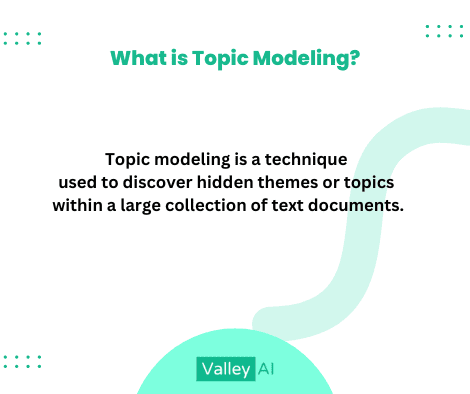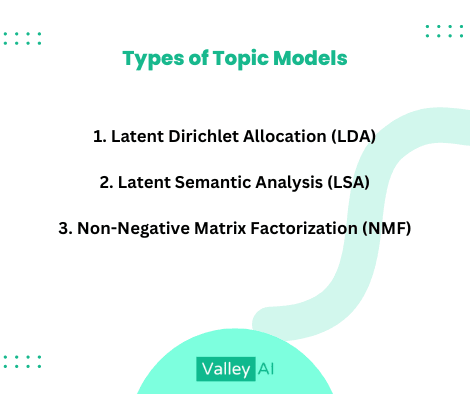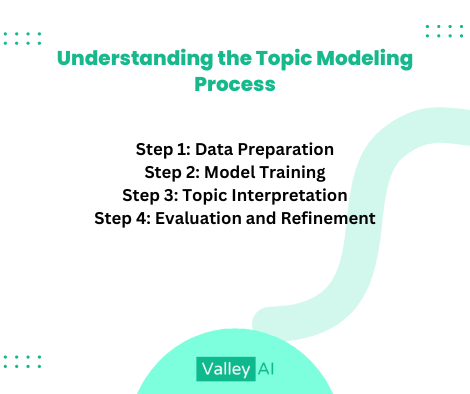In today’s post, we will discuss what is topic modeling, its types, benefits, and best practices. One particular technological advancement is topic modeling, which utilizes Artificial Intelligence (AI) to assist businesses in handling their daily operations, enhancing customer experiences, and optimizing various processes.
In today’s digital era, understanding the vast amount of information available on the web has become increasingly crucial. As users, we seek relevant content that aligns with our interests and needs. Similarly, as content creators, we strive to produce valuable and engaging material that resonates with our target audience.
This is where topic modeling emerges as a powerful technique, enabling us to extract meaningful insights and enhance the effectiveness of our content.
Now, let’s delve into this discussion below without any delay.
What is Topic Modeling?

At its core, topic modeling is a computational method that uncovers hidden patterns and structures within a collection of documents. By employing sophisticated algorithms, it identifies topics or themes that are prevalent across the corpus, offering a comprehensive understanding of the underlying content.
These topics are represented by a distribution of keywords, providing insights into the main concepts and ideas present in the documents.
Types of Topic Models
Several topic modeling algorithms have been developed, each with its own strengths and weaknesses. Here are three popular ones:

1. Latent Dirichlet Allocation (LDA): LDA is a generative probabilistic model that assumes documents are created through a process where topics are randomly selected, and words are then generated based on those topics. It treats documents as mixtures of topics, allowing for the identification of topics and their distribution within the corpus.
2. Latent Semantic Analysis (LSA): LSA, which is also referred to as Latent Semantic Indexing (LSI), employs Singular Value Decomposition (SVD) for examining connections between terms and documents. It detects hidden themes by capturing the inherent semantic framework of the collection of documents.
3. Non-Negative Matrix Factorization (NMF): NMF factorizes the document-term matrix into two non-negative matrices, one representing the topics and the other capturing the term distributions within those topics. NMF aims to find a sparse and non-negative representation of the data, making it interpretable and suitable for topic modeling.
The Power of Topic Modeling
Topic modeling offers several benefits that contribute to the overall success of content creation and information retrieval. Let’s explore some of the key advantages:
1. Organizing and Navigating Large Document Sets
In an age where information overload is a common challenge, topic modeling helps us tame the vast sea of data. By automatically categorizing documents into meaningful topics, we can organize and navigate through large document sets more efficiently. This not only saves time but also allows us to uncover hidden connections and relationships within the data.
2. Improving Information Retrieval
Search engines like Google continually strive to provide users with the most relevant and accurate results. By leveraging topic modeling, search algorithms can better understand the context and relevance of documents, leading to improved search rankings. As content creators, incorporating topic modeling techniques into our SEO strategy can significantly enhance our visibility and reach.
3. Enhancing Content Recommendations
Topic modeling aids in creating personalized and relevant content recommendations. By understanding the topics that resonate with individual users, content platforms can tailor their suggestions, increasing user engagement and satisfaction. This level of personalization not only benefits users but also strengthens the overall content ecosystem.
Understanding the Topic Modeling Process
Now that we appreciate the value of topic modeling, let’s delve into the process itself. Although various algorithms exist, we’ll focus on a popular approach called Latent Dirichlet Allocation (LDA). Here’s a step-by-step breakdown:

Step 1: Data Preparation
To begin, we must gather a substantial collection of documents relevant to our target topic. These documents can be obtained from various sources such as websites, research papers, or social media platforms. Preprocessing techniques, including text cleaning, tokenization, and removal of stop words, are applied to ensure high-quality input.
Step 2: Model Training
Next, we feed the preprocessed data into the LDA algorithm. This algorithm analyzes the co-occurrence patterns of words and assigns probabilities to topics and keywords. Through an iterative process, the algorithm fine-tunes the model to maximize the coherence and interpretability of the topics generated.
Step 3: Topic Interpretation
Once the model is trained, we extract the generated topics and their corresponding keywords. Analyzing these topics helps us gain insights into the main themes present in the document collection. By examining the top keywords associated with each topic, we can label and interpret them accurately.
Step 4: Evaluation and Refinement
Topic modeling is an iterative process that requires evaluation and refinement. We assess the quality and coherence of the topics generated, making adjustments as necessary. This ongoing refinement ensures that the topics accurately represent the content and align with our goals.
Best Practices for Effective Topic Modeling
To achieve optimal results with topic modeling, it is important to follow these best practices:
1. Quality Data Preparation
Ensure that your data is clean, relevant, and representative of the target topic. Remove any irrelevant or noisy documents and perform thorough text preprocessing to eliminate unnecessary noise and improve the accuracy of the model.
2. Optimal Number of Topics
Determining the appropriate number of topics is crucial. While too few topics may oversimplify the content, too many topics can make interpretation challenging. Experiment with different numbers of topics and evaluate their coherence to find the right balance.
3. Interpretability and Labeling
Strive for topics that are easily interpretable and can be labeled accurately. Use the most representative keywords to describe each topic, ensuring that they capture the essence of the content. This enhances the usability and understandability of the generated topics.
4. Regular Model Evaluation
Continuously evaluate the performance of your topic model. Explore metrics such as coherence scores, topic distributions, and topic overlap to assess the quality of the generated topics. Regular evaluation allows you to refine the model and improve its accuracy over time.
5. Iterative Refinement
Topic modeling is an iterative process. As you gain more insights from the generated topics, refine your model by adjusting parameters, fine-tuning preprocessing techniques, or incorporating additional data sources. This iterative approach ensures that your topic model evolves and adapts to the changing needs of your content.
6. Integration with Content Strategy
Integrate topic modeling into your overall content strategy. Analyze the generated topics to identify content gaps or emerging trends, helping you shape your content creation efforts. By aligning your topics with user interests and search trends, you can enhance the visibility and relevance of your content.
Conclusion
In the digital landscape where information overload is the norm, topic modeling empowers content creators and information seekers alike. By unraveling hidden patterns and extracting meaningful topics, we can organize and navigate through large document sets more efficiently.
Moreover, topic modeling enhances search engine optimization by improving search rankings and providing more accurate content recommendations.
To leverage the power of topic modeling, follow the best practices outlined above. Clean and preprocess your data effectively, determine the optimal number of topics, and focus on interpretability and labeling. Regular evaluation and iterative refinement will help you maintain the accuracy and relevance of your topic model over time.
By incorporating topic modeling into your content strategy, you can create engaging, relevant, and valuable content that stands out in the digital realm, outranking other websites and captivating your target audience.
Remember, the journey toward mastering topic modeling is ongoing. Stay curious, adapt to emerging techniques, and continuously refine your approach to unlock its full potential in the ever-evolving landscape of content creation and information retrieval.
- Understanding the Landscape of Cloud Vulnerability Management - March 25, 2024
- Quality Assurance Strategies for Startups: Ensuring Software Reliability - March 5, 2024
- Working of NLP to Improve Copywriting in AI Paraphrasing Tool - February 28, 2024

